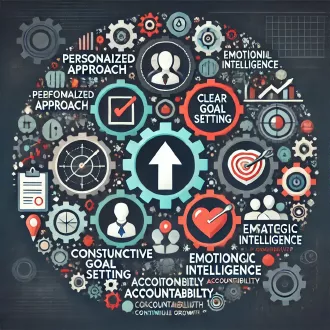Transcription Pattern of successful meetings
In leadership coaching, conducting effective meetings is essential to achieving meaningful results. A successful meeting pattern establishes a structure and flow that maximizes time, encourages participation and allows for steady progress in the coaching process.
In establishing an effective coaching relationship with your coachee it is essential to have a solid structure for meetings and to maintain a regular pattern of meetings. Consistency in regular meetings is key to driving behavior change and growth. Avoid the idea that meetings should only occur when a need arises, as this approach is usually not effective. Instead, establish a pattern that lays a foundation for ongoing communication.
Although it may seem that the first few meetings may lack content, simply being consistent contributes to the desired change in behavior.
Here we explore the key elements of a successful meeting pattern:
- Gather facts and hard data: the foundation of efficient management and effective coaching is to be grounded in real data rather than emotions or assumptions. By focusing on performance and predefined key variables, a solid ground for decision making and goal setting is created. It is a way to visualize progress together, while delving into possible triggers for changes in data and facts How are you doing? What has changed since the last time you met? Does the coachee know what the change is due to?
- Listen more than you talk: your role as a coach is to guide through powerful questions that motivate the client to take productive action. In addition to data, seek to understand current developments and any changes in the environment that may influence the process.
- Acknowledge progress: this is critical in any development process. As a coach, you should celebrate achievements and acknowledge the positive steps your client has taken. This positive reinforcement drives motivation and the trusting relationship between coach and client. One of the coach's roles is that of motivator, so as you check on the coachee's progress think of any details that deserve recognition.
- Establish next action steps: by identifying specific actions that need to be addressed before the next meeting. These steps are stepping stones to continuous improvement and should be defined and followed by the client. Establish action patterns at all meetings so that the coachee knows that there is continuity, and that the next time you meet, you will ask about what you agreed to do. This increases the sense of accountability and motivates the coachee to strive to do the tasks he or she set out to do.
- Remember the overall challenge: the desired goal provides a clear perspective. Motivation is strengthened by keeping the goal in mind and understanding how each step contributes to achieving it. The coach must keep the sense of purpose alive in the coachee's mind.
- Problem solve together: address obstacles the coachee may have encountered in implementing the agreed-upon actions. Use your experience and knowledge to guide him/her through these situations, encouraging creative problem solving.
- Do a meeting wrap-up: at the conclusion of each meeting, summari
employer meeting




